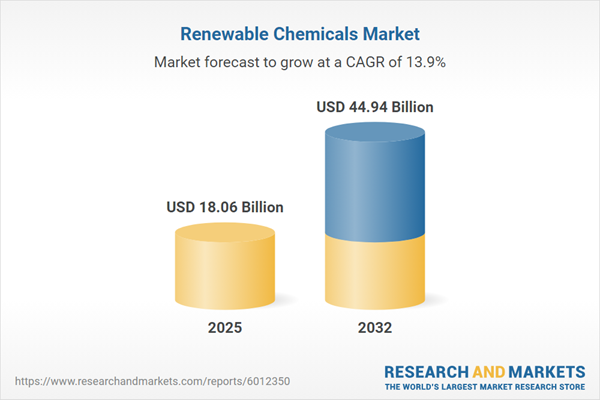Speak directly to the analyst to clarify any post sales queries you may have.
The renewable chemicals market is a cornerstone for organizations seeking to align sustainability with commercial objectives, supporting supply chain resilience and regulatory compliance through bio-based, circular solutions. Senior decision-makers find these innovations integral for capturing future opportunities and driving operational agility.
Market Snapshot: Renewable Chemicals Market Growth and Outlook
The renewable chemicals market demonstrates robust expansion as companies embed sustainable practices into core operations. Regulatory scrutiny has intensified, encouraging accelerated adoption of alternative, eco-conscious materials across diverse industries. Executive leaders recognize the strategic value of transparency and traceability to address evolving customer demands. Industrial sectors such as automotive, packaging, electronics, and construction are rapidly transitioning towards bio-based production models, using renewable chemicals to gain differentiation and resilience. The market plays a pivotal role in underpinning global supply chain transformations and serves as a foundation for organizations’ long-term adaptability within a changing competitive landscape.
Scope & Segmentation: Comprehensive Overview of the Renewable Chemicals Market
- Product Types: Polymer commodities, solvents, surfactants, additives, adhesives, and coatings form the hardware enabling manufacturers to enhance supply chain efficiency and optimize workflows across several industry applications.
- Applications: Automotive, construction, electronics, packaging, and textiles leverage renewable chemicals to strengthen operational effectiveness, pursue regulatory alignment, and foster innovation-driven strategic objectives.
- End-Use Industries: Automotive, consumer goods, construction, electronics, and packaging sectors increasingly implement circular production ecosystems and renewable feedstocks to address compliance and advance sustainability initiatives.
- Raw Material Types: Feedstocks range from algae and various forms of biomass (including corn, lignocellulose, and agricultural byproducts) to sugarcane, carbon dioxide, and municipal waste, ensuring enhanced resource utilization and minimization of emissions along with supply risk management.
- Technologies: Catalytic conversion, enzymatic processes, fermentation, and gasification contribute to production efficiency, enable innovative solutions, and support companies in maintaining regulatory alignment as technology standards evolve.
- Geographic Coverage: The Americas, Europe, Middle East & Africa, and Asia-Pacific exercise distinct development trajectories due to differences in raw material accessibility, regulatory regimes, and research activity across principal markets such as the United States, Germany, China, and Australia.
- Company Profiles: Leadership from BASF SE, Dow Inc., DuPont de Nemours, Archer-Daniels-Midland Company, Evonik Industries, Koninklijke DSM N.V., Corbion N.V., Cargill, Novozymes A/S, and Braskem S.A. is reshaping the sector, advancing technological standards and strengthening agile supply chain systems.
Key Takeaways: Strategic Insights for Senior Decision-Makers
- Industry collaboration across the value chain—among suppliers, producers, and technology partners—drives more effective and agile integration of renewable chemicals into varied manufacturing workflows.
- Employing life cycle assessments and embedding circular economic principles improves compliance and heightens the efficiency of sustainability initiatives in large-scale settings.
- Deploying digital traceability platforms and leveraging predictive analytics enhance visibility, allowing organizations to make real-time, data-driven supply chain decisions and increase market responsiveness.
- Building robust supplier networks and prioritizing local partnerships safeguard business continuity, particularly when adapting to policy or regulatory shifts impacting the renewable chemicals market.
- Customizing go-to-market models to reflect local raw material availability, regulation, and level of innovation activity is crucial to product positioning and maintaining an agile competitive stance.
- Fostering collaborative research and embracing modular production approaches accelerate commercialization of new renewable chemical solutions while mitigating infrastructure-related capital expenditure.
Tariff Impact: Navigating Shifting Trade Dynamics
Recent changes to tariff structures in the United States, affecting select renewable chemicals, have prompted companies to reexamine sourcing and production strategies. There is a growing emphasis on domestic manufacturing and local feedstock procurement, as organizations adapt to new regulatory norms while seeking cost efficiencies. This shift increases the value of harmonized logistics planning and dynamic supply chain models, supporting ongoing operations as global trade and regulatory landscapes remain fluid.
Methodology & Data Sources
This report draws from academic publications, patent analyses, financial disclosures, and direct executive interviews to provide actionable intelligence. These diversified data sources form a foundation for interpreting trends relevant to decision-makers in the renewable chemicals sector.
Why This Report Matters
- Senior leaders access meaningful recommendations for investment strategies, partnership development, and procurement planning—each aligned with increasing sustainability and regulatory compliance demands.
- Detailed segmentation facilitates technology adoption and allows organizations to swiftly adapt to changing regulatory frameworks in commercial focus areas.
- Companies can efficiently identify risk factors, capitalize on innovation opportunities, and ensure continuity with shifting industry and policy dynamics.
Conclusion
The renewable chemicals market delivers actionable pathways for sustainable expansion and organizational adaptability. Strategic execution in this landscape positions businesses to accelerate innovation, respond proactively to regulatory change, and develop resilient value chains.
Additional Product Information:
- Purchase of this report includes 1 year online access with quarterly updates.
- This report can be updated on request. Please contact our Customer Experience team using the Ask a Question widget on our website.
Table of Contents
3. Executive Summary
4. Market Overview
7. Cumulative Impact of Artificial Intelligence 2025
List of Figures
Companies Mentioned
The companies profiled in this Renewable Chemicals market report include:- BASF SE
- Dow Inc.
- DuPont de Nemours, Inc.
- Archer-Daniels-Midland Company
- Evonik Industries AG
- Koninklijke DSM N.V.
- Corbion N.V.
- Cargill, Incorporated
- Novozymes A/S
- Braskem S.A.
Table Information
| Report Attribute | Details |
|---|---|
| No. of Pages | 191 |
| Published | November 2025 |
| Forecast Period | 2025 - 2032 |
| Estimated Market Value ( USD | $ 18.06 Billion |
| Forecasted Market Value ( USD | $ 44.94 Billion |
| Compound Annual Growth Rate | 13.9% |
| Regions Covered | Global |
| No. of Companies Mentioned | 11 |









